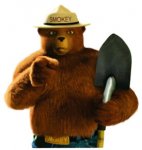magnusmalkus
First Post
Ok... quick setup..
The PC's are battling spiders in a very densely packed pine forest. Flammable spider webbing hangs all around in mighty abundance.
The PC's are evenly matched but are approaching a disadvantage due to waning resources. One of the party members has fallen twice already. Dire circumstances call for dire actions... they decide to set the webbing on fire (yet, they NEVER considered retreat /eyeroll).
What now? I think I realize it's a TOTAL DM's call... but... barring injecting TOO much 'reality' into this situation, what might be some consequences?
The forest is very dense and wild. There is no easily discernible trail. It is daytime, but the forest is dark due to a tight canopy further enshrouded due to a very high density of spider webbing among the branches (these monstrous spiders trap birds). The players have no ranger or druid in the party, the party has been relying on untrained survival checks to navigate their way to their destination.
What about the rate the fire spreads? Can the PC's outrun it in these circumstances? What kind of shelter would protect them (a deep cave, most likely... but anything else)? What about smoke? What else have I not thought of?
Help please?!
The PC's are battling spiders in a very densely packed pine forest. Flammable spider webbing hangs all around in mighty abundance.
The PC's are evenly matched but are approaching a disadvantage due to waning resources. One of the party members has fallen twice already. Dire circumstances call for dire actions... they decide to set the webbing on fire (yet, they NEVER considered retreat /eyeroll).
What now? I think I realize it's a TOTAL DM's call... but... barring injecting TOO much 'reality' into this situation, what might be some consequences?
The forest is very dense and wild. There is no easily discernible trail. It is daytime, but the forest is dark due to a tight canopy further enshrouded due to a very high density of spider webbing among the branches (these monstrous spiders trap birds). The players have no ranger or druid in the party, the party has been relying on untrained survival checks to navigate their way to their destination.
What about the rate the fire spreads? Can the PC's outrun it in these circumstances? What kind of shelter would protect them (a deep cave, most likely... but anything else)? What about smoke? What else have I not thought of?
Help please?!


